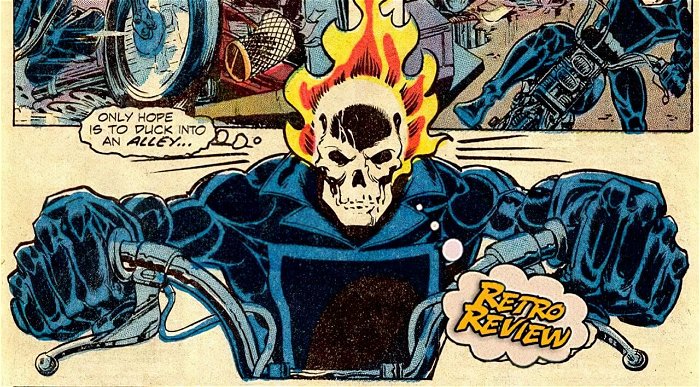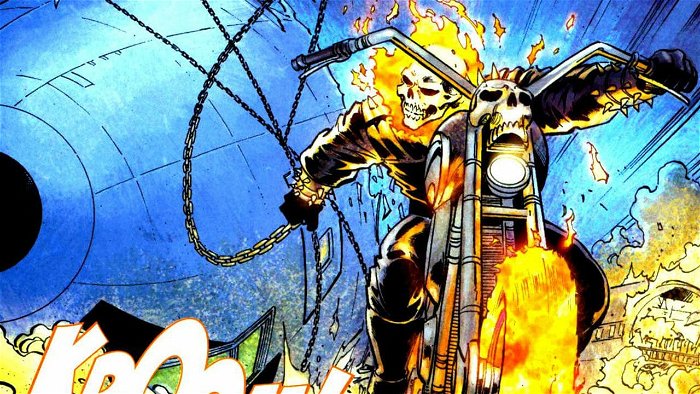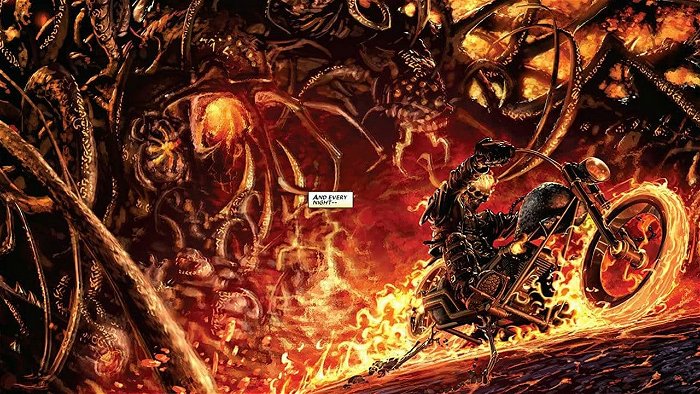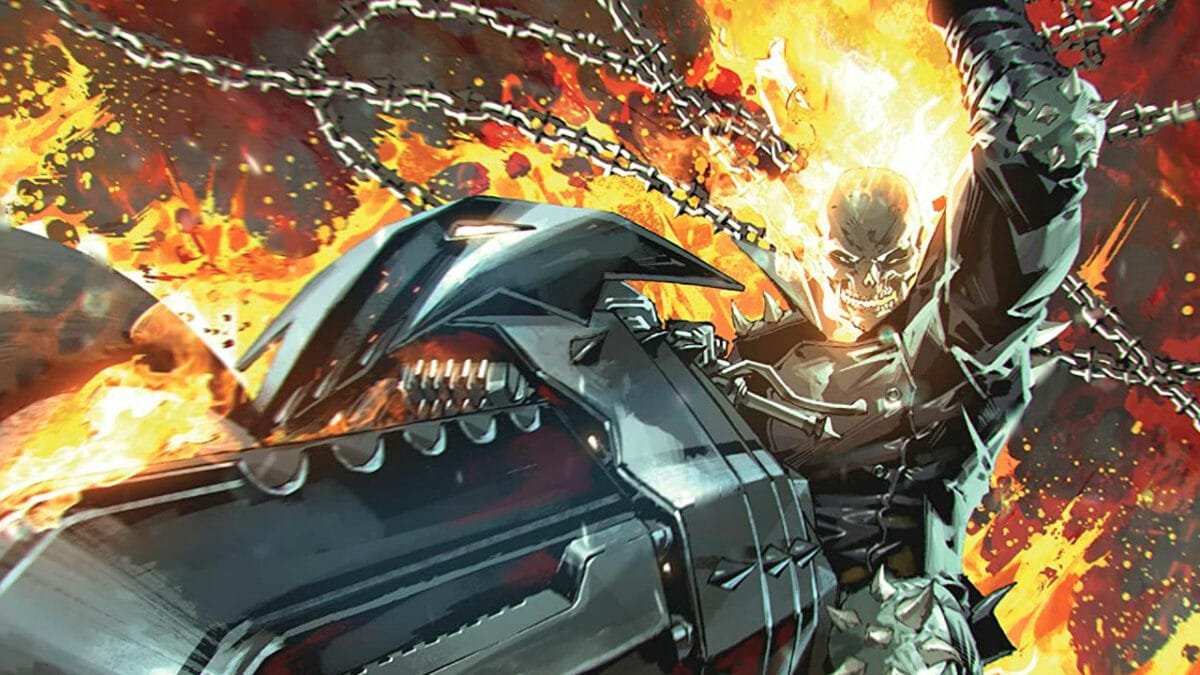With the recent news of Ryan Gosling wanting to play the role of Ghost Rider in the MCU, it felt like time to look back on one of Marvel’s edgiest superheroes. The release of the Mark Steven Johnson film based on the Marvel Comics character Ghost Rider is probably the first time a lot of people have ever heard of the Spirit of Vengeance. “Spirit of Vengeance” you say…I’m intrigued.
Yes, surely there is meaning in the character beyond the righteously cool visual of motorcycle riding stunt man with a flaming skull where his head should be. The literary origins of Ghost Rider are sorted indeed, as he has starred in no fewer than four regular series as well as numerous one-shots, spin-offs and mini-series ever since he first appeared in Marvel Spotlight #5 in August 1972.

Truth be told, the character came to be five years earlier as a western adventure comic featuring a six-gun hero saving the day in the Old West. Ghost Rider #1 came out in February 1967 and it was created by writers Roy Thomas and Gary Friedrich and artist Dick Ayers. The comic did not catch on and it was cancelled by issue seven.
The character though continued on into anthology books like Western Gunfighters and appeared in stories throughout the 70s. Thomas and Friedrich decided to try a different approach to the Rider and once the new character became a hit the original western Ghost Rider was rechristened the Night Rider until that name’s association with the Ku Klux Klan forced another name change to Phantom Rider.
Artist Mike Ploog joined Thomas and Friedrich on the first adventure of the new Ghost Rider, a circus stunt motorcyclist named Johnny Blaze. In order to save the life of his stepfather, Johnny sold his soul to the Devil. The Devil, in turn, bound Johnny’s soul to the demon Zarathos, it was an act of revenge for the fact that Johnny’s love Roxanne was able to drive him away with the power of her emotions, especially her love for Johnny.
Zarathos had consumed souls for eons and his joining with Johnny created the Spirit of Vengeance, the Devil’s own bounty hunter, who’s charged with bringing in the damned. In a retcon later on, it was revealed that the Devil figure was really Marvel bad guy Mephisto, but this fact has also seemed to have retconned back to the original version.

In 1973, Ghost Rider got a start in his own book, and penciller Jim Mooney came aboard to illustrate his new, ongoing monthly adventures. As the series progressed, Johnny started getting more control over his abilities, but his control was balanced by the growing power of Zarathos.
Michael Fleisher began writing the comic with issue 58, and was an interesting choice given that at the same time he was writing the equally dark themed Western character Jonah Hex for DC Comics. Eventually, poor sales led to the cancellation of Ghost Rider in 1983 with issue 81, where Blaze and Zarathos parted ways.
By 1990, the public thirst for darker superheroes, spurred on by huge sales for characters like Wolverine and the Punisher, made Marvel decide that the time was right for the return of Ghost Rider. Written by Howard Mackie and drawn by Javier Saltares, the new Ghost Rider book also featured a new Ghost Rider.
This time the man hiding the flaming skull was Danny Ketch, who discovers a motorcycle with a magical sigil as he and his sister Barbara hide from gangsters. Barbara is seriously injured and eventually dies. Danny pursues the lonely road alone as the new Ghost Rider, protecting innocents from the forces of darkness.

This Ghost Rider was an immediate success and soon inspired a number of companion books, all part of a line called “Midnight Sons”, to be launched as well. This Ghost Rider was featured in other books as part of a number of high profile team-ups; he fought alongside the X-Men in one crossover and was part of an ad hoc Fantastic Four with Spider-Man, Wolverine and Hulk in another. Eventually, Johnny Blaze was reintroduced into the series, and it was later revealed that Blaze and Ketch were, in fact, half brothers with the same mother.
“You can’t keep a good ghost, or a Ghost Rider, down for long…”
However, like the previous series, this Ghost Rider began facing slumping sales that forced writers and editors into a series of stunts that just kept losing more and more readers anyway. The final issue was published in February 1998, but in this there was some controversy, as there was in fact one more issue to go—number 94—and the final storyline of the Danny Ketch Ghost Rider was left hanging for almost ten years until Marvel finally released the issue this past February.
You can’t keep a good ghost, or a Ghost Rider, down for long though. In 2001, under the Marvel Knights imprint, Marvel gave Johnny Blaze another go with the six-part miniseries The Hammer Lane written by Devin Grayson and pencilled by Trent Kaniuga. When Mark Steven Johnson announced plans for a Ghost Rider movie, Marvel made sure it got some plans going for the Ghost Rider comic.

In 2005, Garth Ennis, the celebrated writer of Vertigo’s Preacher, chronicled Johnny Blaze’s trials in the Hell in the Road to Damnation miniseries, which led, more or less, directly into the current series by Daniel Way and Mark Texeira, a popular artist on the 90s Rider series.
The Ghost Rider on screens everywhere is an amalgamation of the Blaze and Ketch Ghost Riders; it combines Blaze’s backstory with the look and powers of Ketch, including the use of chains and the “Penance stare”. Ghost Rider has always been plagued by short-term success.
None of his series have ever passed the one hundred issue mark and while they start out strong, the stories always kind of seem to peter out after a while. Regardless, the flaming skull of the Rider is one of the unique and powerful visuals in American superhero comics, and as experience has taught us, sometimes a really cool-looking character can carry a concept a long way.




